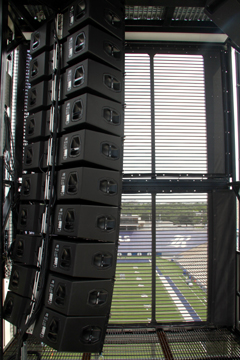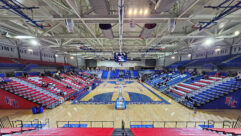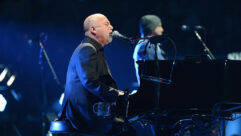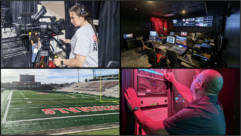
SVC Podcast – Show Notes – Show 165-2
In this edition of the SVC Podcast, SVC Contributing Editor Bennett Liles talks with Zach Richards and Mark May of Big House Sound. They provide more details on the design and installation of the new sound system for the Rice University football stadium and the challenges they faced with the project. Zach and Mark discuss the Yamaha QL1 mixer and its features and they explore open air monitoring vs. using speakers at the sound control point. Also mentioned are the power backup and system failover capabilities.
For Part 1
Links of interest:
- Yamaha QL1 mixer used at the sound control point
- QSC Q-Sys CORE 500i DSP
- JBL AWC129 All-weather compact 2-way speakers
- Listen Technologies LS-58-216 Assisted Listening
Download Podcast Here:
https://s3.amazonaws.com/nb-svc/public/public/165-2_Rice_University_Soun…
This is the SVC Podcast from Sound & Video Contractor Magazine with Zach Richards and Mark May of Big House Sound. Show notes and equipment links for the podcast are on the web site of Sound & Video Contractor Magazine at svconline.com.
The huge new video display at Rice University’s football stadium had to have big sound to go with it. Big House Sound lived up to its name on this project and now the fans have big sound to go with the new giant video display. Zach Richards and Mark May are here to fill out the technical details on how they got it all in and how it works. That’s all coming up right here on the SVC Podcast.
Zach and Mark, thanks for getting with us on the SVC Podcast from Big House Sound in Austin, Texas. We’ve been talking about the Rice University stadium sound system which you installed. We already had done a couple of podcasts on the big new scoreboard video display they have but it was obvious that if you don’t have big enough sound to go with those giant images it’s just not going to be right. So how do you get sound all over the stadium? There are lots of places for it to go so how is the sound distributed around that place?
Zach: Well Bennett, thanks for having us again. I really appreciate it. That’s a great question. We were fortunate, I think, with Rice. The layout of the stadium is such that we were able to really cover pretty much every seat from the sources that are at the video wall there. And we’re using two of the d&b line arrays, one on either side, to cover the majority of all the listening areas. Because of the construction of the stadium a lot of that energy actually does make it to the concourse level. The specification did not call for additional audio sources in the concourse levels so there’s not a distributed system there. And then in the press suites and VIP suites of course we’ve got a distributed system in those areas as well. But those are completely enclosed and independent zones for all of those suites. But yeah, the majority of the coverage we’re providing with the d&b line arrays from the LED wall structure. [Timestamp: 2:10]
And they’ve got, I believe, a Yamaha QL1 mixer for the stadium sound control. That seems to be a pretty simple one to operate. Do its features match the application fairly well? I would think that you don’t need a lot of sub-grouping or anything like that for this.
Zach: Well, that’s exactly right. It’s a great selection, I think, for this application. It is relatively easy to use and they do have operators that are coming in and needing to be able to just make some simple adjustments. However, there’s a lot of powerful features within the QL1 that we’re utilizing as well – and I’ll let Mark speak to it a little bit – but we are, because we’re sending all of our press feeds and so on and so forth via Dante, the QL1 is a great resource there so we’ve got a lot of stuff sub-grouped and going out via Dante that’s really helped to make it on the one hand really easy to use for the operator that’s there, but a lot of stuff happening behind the scenes. And Mark, do you want to explain a little bit about how we’re doing those press feeds and additional audio distribution via Dante?
Mark: Well, yes. The Dante comes out of the console and goes straight to Q-SYS and then from there we’re actually able to distribute it back to the broadcast feeds and the press booths as well. And so it’s Dante going from the console and the Q-SYS. [Timestamp: 3:28]
Yeah and we talked before about the broadcasts and they’ve got a broadcast breakout panel there as most stadiums do for the trucks when they come in. I’ve never done PA at a big stadium but it’s got to be a little strange for the monitoring. You’ve got a big delay there. Do they just monitor it from the open air or do you have monitor speakers at the mixer?
Zach: It’s actually set up so they do have a monitor in the press booth, but when we were there for the first game they actually opened up the window and preferred to listen to the direct sound coming from the main arrays at the video board. Even with the delay, no issues. [Timestamp: 4:02]
Well, if the sound is coming right off the stadium speakers through the open window there’s not much that can go wrong with your monitoring system then.
Zach: Yeah. I think that’s exactly it. It’s just the connection between the folks that are operating the system and the announcer who’s also in that same room and what’s actually happening on the field and in the stands there. We’re in Texas so luckily we can open the window and it’s nice weather and do it that way. But yeah, there is an auxiliary monitor system set up. I’m not sure they will use it that often, but it’s certainly a part of the system as well if needed. [Timestamp: 4:33]
And power being the most basic part of it, how is the system powered? Do they have any kind of power backup? I would think that during a day game the video display goes dark and the sound system goes quiet but the people in the stands couldn’t tell that much otherwise but of course the game would have to stop.
Zach: That’s right. There were discussions early on about what level of power backup really needed to be provided. The logic was that if there was a power failure if would most likely affect not only the audio system but the video system as well and a lot of the network items associated with it. So there is not a backup battery system for the amplification portion of the system, however the network and all of the DSP is put on a battery backup so that if there’s like a short outage or temporary outage that all that stuff stays maintained so that when the power does come back on there’s not a long reboot cycle associated with any of that equipment. And you know I think every area, but certainly we’ve seen it in central Texas, is prone to brown outs or just shorter fluctuations in power so having the UPS equipment on the more sensitive items to prevent the system from having to reboot is a smart thing. So we do have that configured for both the networks which is – and also the Q- SYS cores as well. Another thing that we implemented in the design of the things was a redundant core system and Mark maybe you can just take a couple of minutes and explain how that works.
Mark: The Q-SYS system, the brains of it, are the Core 500i’s, two of them. With the way Q-SYS’s work is you basically put the first core, the main core, into a redundant mode and the next core will follow suit on everything. But I mean this is an awesome feature to have. So with this feature we also wanted to make sure that we kept everything digital as well going from the cores to the d&b amplifiers. So with each core we’re sending out as AES line to each amplifier and to make sure that we didn’t have any issues with the AES aspect of it and the clocking we were able to take advantage of the d&b amplifiers with their SRC mode, sample rate converter, which is pretty neat to where we can have both cores feeding a d&b amplifier and not have any issues with clocking and everything. If the first core down within about three seconds to four seconds it will switch over and the sound continues to go on without any issues – the first core went down.
Zach: A small glitch, but hopefully no one notices that. And then it’s also configured with analog backup lines as well so if for some reason we had a failure in the digital signal path at least between the Q- SYS cores and the amplifiers then they could be switched to an analog backup mode as well. We really try to do as much as possible to make the system as bullet proof as possible to make sure that every game is a success for them. [Timestamp: 7:37]
Well, it’s good to be able to fall back on the old three-wire if you need it.
Zach: Absolutely. Absolutely.
Mark: Yes.
What are the system’s remote control capabilities? Do they have a web interface?
Zach: Mark, do you want to answer to that because you were just working on it earlier this week.
Mark: Sure. We do have what Q- SYS would call a UCI user interface where they can log on in the broadcast booth and be able to monitor and maintain the system there. And there’s a few different pages, a page that allows them to turn on and off the system and be able to control some of the key volume parameters. And then on a couple of the other pages they’re all for monitoring purposes and it’s actually set to be able to talk between Q- SYS and the d&b amplification for the main arrays so if there’s any issues it will actually flash on the CCI and let us know that there’s an issue. And then as well the CCI is actually capable of going through Wi-Fi so they actually have a laptop in the press booth as well that they’re on Wi-Fi and they are able to hook up and monitor the system. [Timestamp: 8:45]
I know it’s not all just football game all the time. They have some ceremonial events out on the field. Are there different presets, say on the Q-SYS for the various events?
Zach: There aren’t presets within Q-SYS specifically for different types of events. However there is an on-field system that just covers the field itself as well as the main stadium system. So depending on the type of event those two can be switched between. And then there probably will be presets that are forthcoming for the console itself to capture different types of events and so on and so forth. But for the most part all of those types of preset changes would happen within the QL1 and at the operator’s discretion for that as well. [Timestamp: 9:27]
Well, it’s got to be pretty exciting to be the sound op on the game and know that all of these thousands of people are listening to your work. I think most of these stadiums have some sort of assisted listening system as well.
Zach: Yeah, that’s correct. There is an assisted listening system that’s part of the configuration. Pretty standard with the exception of just needing to make sure that we had proper coverage because it’s quite a large stadium as you can imagine so the transmitter resides in the press booth there in the control room and has a discrete feed but then distributes that via a single FM transmitter to a number of belt packs and receivers as needed. So absolutely. [Timestamp: 10:03]
That could be interesting for someone who needed that in the middle of all that crowd noise going on, to be able to tell who the players are and so forth.
Zach: Well, absolutely. And it’s fairly commonplace these days. It’s something we’d like to see in every system design because not all – not everyone has the luxury to have that perfect hearing or whatnot and the crowd noise can get quite disruptive. So having the assisted listening system is certainly a benefit for some folks and we’re glad to be able to provide it. [Timestamp: 10:31]
So you have this one done and it looks like it all works fine and I know you’re proud of it so what’s coming up next for Big House Sound as far as projects in the works?
Zach: We definitely to have some stuff in the works. We’re working on a couple of other athletic facilities that we’re excited about and with this project and really getting to hear and feel what the d&b J-series system can do in a stadium like this where we’re really excited about the opportunities with these d&b systems. It’s a system that has not really been used previously in large format stadiums. This has been the first J-series installation in a major football stadium, at least in North America. So yeah, we’re excited about getting to hear what this system can do in some other facilities that we’re working on here in the next year or so. [Timestamp: 11:15]
Well, that could open a whole new marketing aspect for d&b for outdoor stadium sound systems. Great hearing about this one. Zach Richards and Mark May from Big House Sound in Austin and the new Rice University football stadium sound system.
Zach: Thank you very much, Bennett. We certainly appreciate the time and look forward to hearing it.
Mark: Thank you.
Thanks to Zach Richards and Mark May for joining us on the podcast. Show notes and equipment links are on the website of Sound & Video Contractor Magazine at svconline.com. Be back with us again for the next SVC Podcast.










